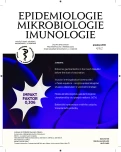Invasive meningococcal disease in the Czech Republic – analysis of the epidemiological situation and vaccination strategy recommendations
Authors:
Křížová Pavla; Vacková Zuzana; Musílek Martin; Kozáková Jana
Authors‘ workplace:
NRL pro meningokokové nákazy, SZÚ, Praha
Published in:
Epidemiol. Mikrobiol. Imunol. 62, 2013, č. 4, s. 138-147
Overview
Aims:
Analysis of invasive meningococcal disease (IMD) surveillance data including molecular epidemiology data. Vaccination strategy recommendations based on the current epidemiological situation of IMD in the Czech Republic and availability of meningococcal vaccines.
Material and methods:
IMD surveillance data are compiled by the National Reference Laboratory for Meningococcal Disease (NRL) from routinely reported data and NRL data after clearing out duplicate data. Neisseria meningitidis (N.m.) isolates referred to the NRL are confirmed and characterized in detail according to internationally validated methods.
Results:
The current epidemiological situation of IMD is relatively favourable – the incidence rates have been below 1/100,000 population for several years, but show a slightly upward trend over more than 40-year period (1970–2012). A return to the typical prevalence of serogroup B accounting for up to 75% of cases has recently been shown. In this context, the upward trend in IMD caused by serogroup Y associated with a high case fatality rate in the Czech Republic cannot be overseen or even underestimated. The hypervirulent clonal complex cc11 characteristic of N.m.C:2a:P1.2,5 prevailed in this country between 1993 and 2004, but decreased in the following years and currently, hypervirulent clonal complexes characteristic of N.m.B (cc18, cc32, cc41/44, and cc269) are the most common in the Czech Republic. The average overall case fatality rate in the Czech Republic is 10%, but varies between causative serogroups: the highest case fatality rate has been caused by serogroup Y (16.7% ), followed by serogroup C (12.3%), and serogroup W135 (11.7%), while serogroup B only accounts for a case fatality rate of 7.8%. In the age group under one year, the incidence of IMD caused by serogroup B remains three to five times as high as in the age groups 1–4 years and 15–19 years throughout the surveillance period. The highest numbers of IMD cases caused by serogroup B have been reported in 3-7-month-olds.
Conclusion:
Based on the IMD surveillance data from the Czech Republic, the NRL recommends a vaccination strategy to provide an adequate protection to individuals. To induce an immune response as wide as possible, the tetravalent meningococcal conjugate vaccine A,C,Y,W135 in combination with the newly registered MenB vaccine designed by reverse vaccinology should be given. To maintain immunity, subsequent booster doses are required at intervals depending on the primary vaccination age.
Keywords:
invasive meningococcal disease – surveillance – vaccination strategy – meningococcal vaccine
Sources
1. Black, S. B., Plotkin, S. A. Meningococcal disease from the public health policy perspective. Vaccine, 2012, roč. 30, Suppl 2, s. B37–39.
2. Halperin, S. A., Bettinger, J. A., Greenwood, B. et al. The changing and dynamic epidemiology of meningococcal disease. Vaccine, 2012, roč. 30, Suppl 2, s. B26–36.
3. Kriz, P., Wieffer, H., Holl, K. et al. Changing epidemiology of meningococcal disease in Europe from the mid-20th to the early 21st Century. Expert Review of Vaccines, 2011, roč. 10, s. 1477–1486.
4. Sadafi, M. A., Berezin, E. N., Oselka, G. W. A critical appraisal of the recommendations for the use of meningococcal conjugate vaccines. J. Pediatr. (Rio J), 2012, roč. 88, s. 195–202.
5. Jacobson, R. M., Jackson, L. A., Reisinger, K. et al. Antibody persistence and response to a booster dose of a quadrivalent conjugate vaccine for meningococcal disease in adolescents. Pediatr. Infect. Dis. J., 2013, roč. 32, doi: 10.1097/INF.0b013e318279ac38.
6. Khatami, A., Snape, M. D., Davis, E. et al. Persistence of the immune response at 5 years of age following infant immunisation with investigational quadrivalent MenACWY conjugate vaccine formulations. Vaccine, 2012, roč. 30, s. 2831–2838.
7. Broker, M., Jacobsson, S., Kuusi, M. et al. Meningococcal serogroup Y emergence in Europe: Update 2011. Hum. Vaccin. Immunother., 2012, roč. 8, 12. [Epub ahead of print]
8. European Centre for Disease Prevention and Control (ECDC). Rapid Risk Assessment. Invasive meningococcal disease among men who have sex with men. Stockholm: 2013 (http://www.ecdc.europa.eu/en/publications/Publications/Forms/ECDC_DispForm.aspx?ID= 1158.
9. Vogel, U., Taha, M. K., Vazquez, J. A. et al. Predicted strain coverage of a meningococcal multicomponent vaccine (4CMenB) in Europe: a qualitative and quantitative assessment. Lancet Infect. Dis., 2013, roč. 13, s. 416–425.
Labels
Hygiene and epidemiology Medical virology Clinical microbiologyArticle was published in
Epidemiology, Microbiology, Immunology

2013 Issue 4
Most read in this issue
- Bacterial contamination of the indoor air in a transplant unit
- Molecular biological and epidemiological characteristics of the varicella-zoster virus (VZV)
- Invasive meningococcal disease in the Czech Republic – analysis of the epidemiological situation and vaccination strategy recommendations
- Rotavirus gastroenteritis in the Czech Republic before the start of vaccination
